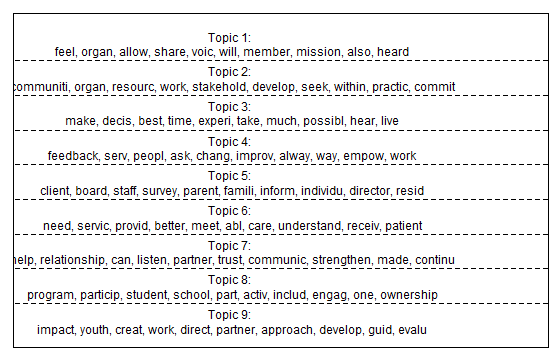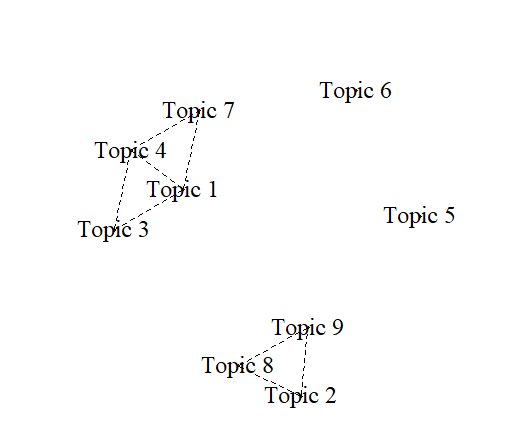“How has asking for feedback from the people you serve changed your relationship with them or shifted power – over decisions, resources, rules, or in other ways – to them?”
I joined Feedback Labs because I wanted to contribute to creating more equitable power dynamics in the nonprofit sector – where the people being served often have no say in the services being provided to them. An increasing number of nonprofits are working to change that. They’re listening to the people they serve to shift more power to them. And their self-reflections on how listening is transforming their relationships with the people they serve, shared in the How We Listen section on GuideStar by Candid, give us some exciting initial insights into how feedback shifts power dynamics.
Over 11,000 nonprofits have participated in How We Listen to date, demonstrating how excited nonprofits are to share their listening practices. But how could we analyze so many open text reflections on how listening shifts power? Thankfully, the growing field of machine-assisted textual analysis gave us a way to gather initial insights from thousands of nonprofit reflections.
Essentially, we asked a computer program to group reflections from different nonprofits together. The algorithm looked at every word in each response and detected patterns in how the words were used. It clustered responses with similarly used words together into ‘topics’ and produced a table (below) that shows what words are most strongly associated with that topic. I then examined each cluster to interpret what that topic refers to. This approach is called structural topic modeling, and what follows is a comprehensive overview of the preliminary analysis I conducted in this way.
The Top Nine Ways Listening Shifts Power
2,387 nonprofits chose to answer the question, reflecting on how listening has transformed relationships and shifted power to the people they serve. Our text analysis method sorted these 2,387 responses into the following nine topic clusters:

Note that all words from the same word stem are considered as the same word, so “serv” in topic four above includes uses of the words “serving,” “served,” “serves,” and so on.
To find the top ways nonprofits responded to the question “How has asking for feedback from the people you serve changed your relationship with them or shifted power – over decisions, resources, rules or in other ways – to them,” we interpret the words that tend to be associated with each topic. What follows is a tentative description of each topic, along with honest responses from nonprofits that clarify how these top few words under each topic were used:
- Topic 1 – Giving Voice: this topic seems to be about providing a space where the voices of many organizations’ members feel heard.
Example: The Youth and Family Center, which provides food and other supplies for low-income families in St. Louis, Missouri, stated that “It makes our services more personal. They feel respected despite their circumstances. It doesn’t feel like a handout; it feels like empowerment and personalized support.”
- Topic 2 – Resource Allocation: this topic seems to be about the allocation and commitment of resources to different community stakeholders based on feedback.
Example: The Underground Railroad History Project of the Capital Region, which runs public education programs on the continued relevance of Abolition today, stated that “Volunteers fill needs that interest them and their skillset; with their knowledge, we encourage volunteers to establish new projects that they believe will be successful for the organization. The community or the community runs this organization; For instance, a volunteer, a gardener, suggested initiating a gardening program for the Underground railroad. This volunteer believed that the communal use of the gardens would establish a strong foundation for the community it surrounds. Once established, the gardens did just that. Furthermore, several committees are composed of board and community members that offer their skills and expertise to plan and implement the strategic plan that drives the mission forward for years to come.”
- Topic 3 – Decision-Making: this topic seems to focus on feedback’s role in ensuring effective decision-making.
Example: The School of Choice Education Organization, which works with youth living in extreme poverty in Haiti, explained that “As an example, it is important to discuss what we learn with our volunteer parent committee, and also how and why we make decisions. When we implement those decisions, they must hear how we have taken into consideration the feedback they have offered so that they know how much we value that feedback, even if there may be reasons why a particular suggestion is not possible to be implemented at that time.”
- Topic 4 – Serving People Better: this seems to be about feedback allowing organizations to serve people better, improving programs, and empowering the people they work with, which was the most popular topic, encompassing over 15% of all responses.
Example: Rahma Worldwide, which coordinates aid and development among conflict-displaced families in 7 countries, stated that “Those who give advice effectively are always welcome, and shape important decisions positively. A related tendency is to ask for advice when our real goal is to gain valuable honest feedback, and this has made our relationship with beneficiaries more trusting and effective. When we enter into camps and people know who we are and trust that their voice is heard and their needs are being addressed. We actively look for ways to improve our operations through constructive feedback.”
- Topic 5 – Stakeholder Differentiation: this topic seems to focus on the many stakeholders nonprofits have – clients, board members, staff, families, residents, and so on – potentially pointing to feedback practices leading to more fine-grained differentiation of key stakeholders’ needs.
Example: The Center for Child Protection in Travis County, which works to serve child survivors of sexual and physical abuse, said that “Our therapists and Family Advocates are in a constant dialogue with clients and their families about their unique goals and needs with regards to services and intervention methods. In addition to standardized assessments and caregiver surveys given at regular intervals, client input and feedback is used in formulating therapeutic goals and methods. Some children’s age or developmental functioning may lend itself to a unique sensory intervention such as trauma-sensitive yoga or music therapy. Many families who are engaged in Family Relational Therapy benefit from bonding exercises such as working on the ropes course or in the vegetable garden on our campus. The individual needs and input from clients and families is always crucial in the development of treatment planning.”
- Topic 6 – Meeting Needs: this topic appears to be about how feedback helps ensure that services better reflect and meet people’s needs.
Example: The United Cerebral Palsy Association of Central Arizona stated that “We can be more efficient in how we provide service and can be more confident that we are providing services that are needed.”
- Topic 7 – Strengthened Trust in Partnerships: this topic seems to be on the strengthening of relationships with the people a nonprofit serves through better listening
Example: Haiti Partners Inc, which runs educational programs in Haiti, explained that “Since the beginning, we have striven to be as open, transparent and inclusive as possible with the people we serve in Haiti as well as with our supporters and partners in the US and elsewhere. We believe this has made our partnerships deeper and more substantial and has led to stronger, more stable relationships of trust that have helped us work through many challenging times and situations.”
- Topic 8 – Educational Programs: this topic seems to focus on participation in programs, especially among students – possibly pointing to many education-focused nonprofits finding that listening leads to shifts in power dynamics that typically disempower students in school.
Example: The Women’s Education Project, which works to enhance women’s economic independence in India, stated that “From the start of our program in 2002, we have listed to our students needs to develop activities and curriculum. A student was anemic — we started a kitchen garden program and daily nutritious snack. A student didn’t have textbooks receiving a scholarship from WEP to attend college — we started a textbook library program. Since 2019, we have collected these details in regular surveys from our students.”
- Topic 9 – Community-led Shifts in Approach: this topic focuses on how listening leads to significant impact and better approaches.
Example: The Saint Louis Story Stitchers Artists Collective, which works to enhance art engagement among low-income Black youth, explained that “Story Stitchers is a youth-led organization, in that youth guide the direction of the focus of the work, such as gun violence prevention, the neighborhoods where we engage, and the new directions that we move towards, such as providing additional safe spaces for youth to gather, learn, create, and work with mentors. The youth and community provide feedback which guides the leadership and the board towards culturally relevant work that can create systems changes desired by the target population such as racial equity, ending gun violence, and ending implicit racial biases black adolescents and young adults.”
Which Topics are Closely Related?
Now that we have identified critical topics across 2,387 nonprofit responses to how listening shifts power, we can look at which topics tend to be discussed together in a nonprofit’s response. The diagram below shows how the nine issues we identified are related:

Topics one, three, four, and seven – Giving Voice, Decision-Making, Serving People Better, and Strengthened Trust in Partnerships – formed one cluster of topics. It seems that among many of the nonprofits that have participated in How We Listen, one kind of focus on equity (Giving Voice) is closely related to a focus on effectiveness (Decision-Making; Serving People Better) and trust (Strengthened Trust in Partnerships). Many nonprofits seem to echo the sentiment that feedback isn’t just the ‘right’ thing to do, and it’s the smart thing to do! Topics two, eight, and nine – Resource Allocation, Educational Programs, and Community-led Shifts in Approach – are also clustered. It could be that due to the leadership of student listening tools like YouthTruth, nonprofits in the education sector are more practiced at using feedback to allocate resources and shift their approaches, or at least consciously focusing on this community-led approach. However, these are by no means definite conclusions, and much more could be done to examine these correlations.
This analysis is by no means comprehensive, much less exhaustive. Much more needs to be done to extract valuable insights from the How We Listen dataset. Most significantly, how representative is our sample? Given that claiming a Guidestar profile, participating in How We Listen, and answering the How We Listen question about shifting power are all optional exercises, the nonprofits in this sample represent only a tiny subset of nonprofits based in the United States. Still, this preliminary analysis points towards the many insights gained from a deeper analysis of this dataset.
NOTE: The methods I used came from a course by Professor Minsu Park at New York University Abu Dhabi, ‘Textual Analysis for the Social Sciences.’ I am by no means an expert in the field, and would love to see more experienced researchers making use of this How We Listen dataset – through textual analysis methods or otherwise! If you’re interested in analyzing the How We Listen dataset, please contact Megan Campbell at [email protected].

Zhong Chen Tan (he/him), known by many simply as Zack, is a rising junior at New York University Abu Dhabi. Zack was our Summer 2021 Strategy Intern and worked closely with the Irritants and the Feedback Incentive Learning Group to explore ways of strengthening incentives for nonprofits and funders to listen well to their constituents. He also worked to consolidate, analyze, and disseminate the insights gained from these groups so far. As a Social Research and Public Policy major who believes strongly in the value of the ethnographic method in empowering communities, Feedback Labs’ ethos appeals strongly to him. He has done coursework in public health, development studies, and humanitarian aid, impressing upon him the necessity of combining good intentions with deep listening and feedback loops. His on-campus role as a peer counselor with the Health Promotion Office also showed him the impactful nature of active listening. Previously, he was an Innovations Intern with Catalyst 2030 and a UN Online Volunteer with various UN agencies, giving him insight into how social impact work worldwide could be enhanced with effective feedback loops. In his spare time, Zack loves to run, do parkour, travel, read, and learn languages. He is currently fluent in English and Mandarin and is working to improve his intermediate-level Arabic (MSA), French, Spanish, and Korean.







